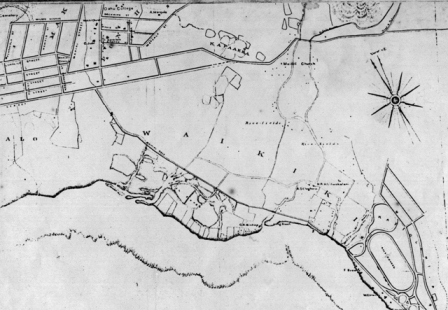March 7, 1792 "Here and there we met with ponds of considerable size, and
besides being well stocked with fish, they swarmed with water fowl of
various kinds such as ducks, coots, water hens, bitterns, plovers and
curlews."
[
Menzies 1920:24]
1821
"All of this land has now been drained and filled; neither fishponds nor
taro lands have survived. In a few instances the taro patches were also
stocked with fish."
[Kotzebue
1821:341],[Sites 282,294, McAllister 1933:76]
May
24, 1823 Anthony Allen-negro. "His plantation is 2 miles from the Mission
House on the plain, towards Waititi. The road to it, although the plain
is uncultivated and entirely unshaded, affords the most pleasant walk in
the immediate vicinity of Honoruru. ...the shore is lined only with
fishponds and marshes."
[Stewart 1970:158]
Tuesday, May 10, 1825. "I walked along the shore towards the bay of
Whyteete to see if i could procure any shells, but I found none worth
picking up. The whole distance to the village of Whyteete is taken up
with innumerable artificial fishponds extending a mile inland from the
shore, in these the fish taken by nets in the sea are put, and though most
of the ponds are fresh water, yet the fish seem to thrive and fatten.
Most of these fish belong to the chiefs, and are caught as wanted. The
ponds are several hundred in number and are the resort of wild ducks and
other water fowl. I found it very difficult to get out of the labyrinth
of paths which led among them."
[Bloxam
1925:35-36].
Monday, May 22nd, 1826 "Dr. B., Mr. L and myself walked to Waititi to view
a fishpond sometime since presented by karaimoku to the mission, but not
taken possession of by us till now. After accomplishing our object and
committing the care of the pond to an old man who resides in the
neighborhood we pursued our walk to Diamond Head."
[Chamberlain 1822-1849: 474].
Thursday, Jan. 29, 1828. "...Our path led us along the borders of
extensive plots of marshy ground, having raised banks on one or more
sides, and which were once filled with water, and replenished abundantly
with esculent fish; but now overgrown with tall rushes waving in the
wind."
[Chamberlain 1956:26]
BACK TO THE TOP
1933. "He [Capt. Douglas] was received very cordially by Titeeree [Kahekili]
who took him round the village, showed him several plantations, and
conducted him to some large ponds, which appeared to be full of fish. He
mentioned also some others where he had a quantity of turtle."
[Meares
1916: 20 ] , [McAllister 1933:76]
1902. "...14 fishponds in use at Kalia and Waikiki, as late as 1901 and
states that those at Waikiki were fresh-water ponds."
[Cobb 1902],[McAllister 1933:76].
"Not
all pu'uone owned by the chiefs were as large as Lelepaua, Ka'elepulu, or
Kawainui Pond. The ponds at Waikiki whose areas are recorded (Cobb
1902:429) were from 1.3 to 13 acres, and some shown in the same area are
on a map made by Monsarrat (1897) were smaller than an acre."
[Summers 1964:22].
"Formerly the number must have been considerably greater."
[McAllister 1933:76].
1919. "Kakuhihewa was the chief of Oahu at that time. He lived at Ulukou
where the Moana Hotel stands and mauka of there he had a fish pond. It is
still seen but is now a place where ducks are raised. A heavy rain fell
until the force of the water broke the walls of the pond. The kahuna
began at once to find a way to save the chief's fish pond and so they took
a black pig and laid it before Kaumana, praying all the while. Kaumana
knew that his end was near so he changed himself into a stone."
[Solomon Kauai-informant to T. Kelsey He mo'olelo kupua no Kaumana i lilo
Pohaku:Kuokoa. July 4, 1919].
[Sterling & Summers 1962. Bk. VI, Vol. 1, Kona 105-106].
|


